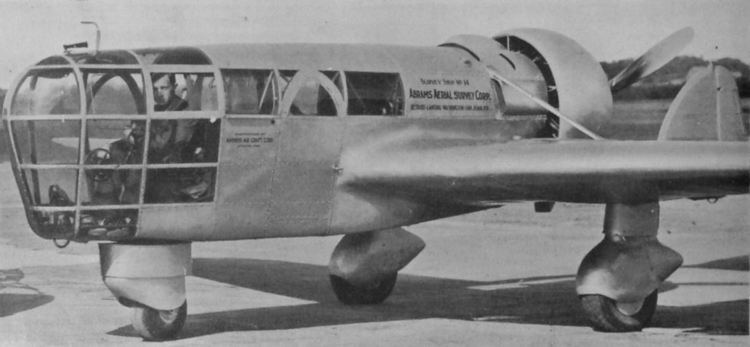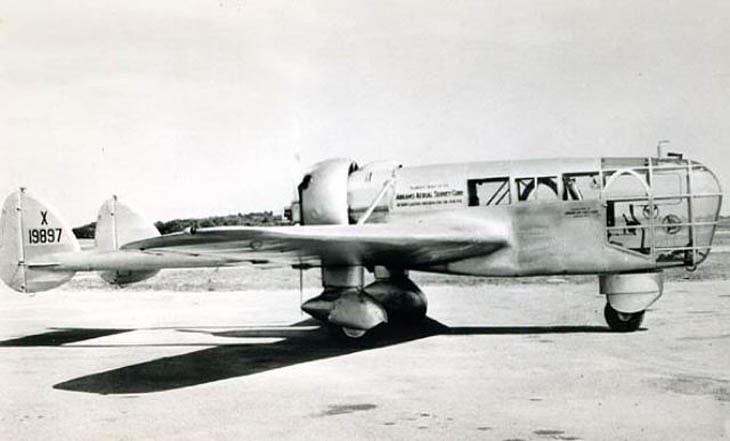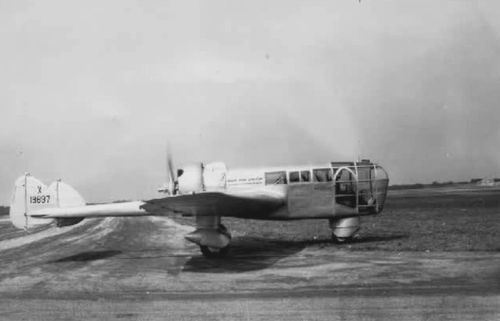Wingspan 12 m Manufacturer Abrams Air Craft | Length 8.08 m | |
 | ||
The Abrams P-1 Explorer was American purpose-designed aerial photography and survey aircraft that first flew in November 1937. It was designed by aerial survey pioneer Talbert Abrams to best suit his needs for a stable aircraft with excellent visibility for this kind of work. Abrams was an early aerial photographer, in World War I. He used a Curtiss Jenny post-war, forming ABC airlines. In 1923 Abrams founded Abrams Aerial Survey Company, and in 1937 Abrams Aircraft Corporation to build the specialized P-1 aircraft.
Contents

Design and development

The standard single, front-engined airplane of this era created many problems for good scientific photography. They were created to be very nimble in the air and rather than stable photographic platforms. Their engines leaked oil which would flow under the aircraft and get on the camera lens. The engines were noisy and the noise flowed back into the cockpit making conversation difficult.

The designer of the Abrams P-1 Explorer conceived a plane with a wide wing span to be more stable, and with a rear engine to keep the camera clear. He wanted a delta type wing so side vision was possible. He hired engineers Kenneth Ronan and Andrew Edward Kunzl in Marshall, Michigan who drew plans and began construction in the old Page Brothers Buggy Company factory.

Ronan and Kunzl operated an aeronautical repair station at the Marshall airfield. Ronan was in the first graduating class of aeronautical engineering from the University of Michigan. Careful planning and ten months of construction produced an airplane capable of more efficient and economical aerial photography.

To create the clear nose, so the pilot had unubstructed view, he called in the German company of Rohm and Haas, creators of Plexiglas. With a wooden, male model of each window pane, the Plexiglas was clamped in a frame much like a window frame. Then heated until it began to sag it was pushed down by two workers holding the frame until it was molded to the wooden model.
The Plexiglas could then be trimmed and mounted in the frame work. When the Explorer came back for restoration, it was those panels which had been heated which survived the years as clear as when new. However through some abuse during disassembly they were destroyed.
It was a low-wing metal monoplane with twin booms and a central nacelle for the pilot and camera equipment. The pod's nose section was extensively glazed in Plexiglas. The undercarriage was fixed and of tricycle configuration.
Variants
Originally powered with a 330 hp (250 kW) engine and a two-bladed propeller it was sent back to Ronan & Kunzul to increase the horsepower to 450, which required braces to be added from the wing top to the fuselage and they added a three-bladed propeller. Ted thought the increase power would bring a buyer to his airplane.
Abrams planned a pressurized version of the P-1, named the PC-4 that did not go into production.
World War II interrupted Abram's work, and the single aircraft built was put into storage for the duration of the war. Obsolete by the end of the conflict, it was donated to the US National Air and Space Museum in 1948, where it remains today awaiting restoration.
Operational History
The P1 was flown with a variety of camera gear. The Abrams Instrument Corporation C-3 camera was used to produce 650 nine by nine inch photos per flight.
In 1968 a number of aviation friends met for lunch including Jim Linn who worked at Abrams Aerial Survey. He mentioned the Explorer and no one in the room had heard of it except one. Ron Dietz, who was a student pilot at that time, went to his car and returned with the May issue of the Private Pilot magazine. Here was a big story with photos of the aircraft.
The idea began that perhaps it was time for Lansing to do something for Mr. Abrams, who often provided financial support when asked. Ellis Hammond, President of the Michigan Aerospace Educational Association and Ron Dietz, engineer at Oldsmobile Division of General Motors, decided to put some time and money into the project.
Having worked with the Smithsonian's National Air and Space Museum's Assistant Director Don Lopez, the aircraft was released. In January 1975 the Explorer flew for the last time. In the belly of a Michigan National Guard C130 it arrived at Capital City Airport in Lansing.
The aircraft was moved to a state owned hangar were Dietz was in charge of careful photography before any disassembly was done. He carefully made tracings of all the lettering so they could be faithfully redone at the end of the project.
The wings were sent to Montcalm Community College where they were carefully stripped, cleaned, repainted and recovered with silver painted fabric. The instruments panels and controls were disassembled and restored by Mr. Dietz's colleagues at Oldsmobile.
The aircraft was physically moved to the Lansing Community College aviation program where I lost daily contact with it. During a visit to the airport Hammond and Dietz lamented at the lack of attention and the shortage of restoration work versus repair work on the aircraft. They agreed to cancel their support of the airplane with the Smithsonian and suggested it was best for all to have the plane returned. In 1981 the Lansing Community College truck driving school took the plane back to Silver Hill, Maryland where it is today.
Media appearances
The Marshall Chronicle of November 25, 1937 carried the story on page one. The Explorer flew the first time on November 20, 1937 from Brooks Field in Marshall.
The Quarterly Journal of the American Society of Photogrammetry said, "this new craft is so unique in design as to resemble the mythical creation of a 'Buck Rogers' space ship of the year 2040". Vol III, number 4, Oct-Dec 1937.
The airplane was in the Sunday newspaper cartoon strip of 'Smilin' Jack' in February 1941. The cigarette company Wings reproduced its image in a color trading card.
Ted tried to interest the movie industry since World War I movies were popular and he tried to interest the military. It seems the military sources simply took the idea of the clear nose and offered it to other aircraft company. The Explorer windows were the first to be formed on a compound curve in history.
Pennsylvania Central Airlines featured the Abrams Explorer on a promotional matchbook cover c.1940.
Specifications
Data from Grey 1972 p.242c
General characteristics
Performance
